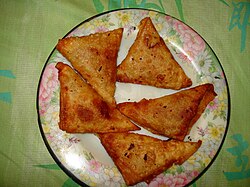Samosa
Samosa is a popular snack originally from Central Asia. It further travelled, with the help of Muslim merchants of trade routes to the Indian subcontinent.[1] It is famous in the subcontinent as well as Southeast Asia, Central Asia, Southwest Asia, the Arabian Peninsula, the Mediterranean, the Horn of Africa, North Africa, as well as South Africa.
 | |
| Alternative names | Samsa, somsa, sambosak, sambusa, samoosa, singada, samuza |
|---|---|
| Region or state | Indian Subcontinent, Central Asia, Western Asia, Horn of Africa, North Africa, South Africa |
| Main ingredients | Maida or plain flour, potato, onion, spices, green chili, cheese, meat |

It is generally prepared in the shape of a triangle, however, the shape and sizes tend to vary from region to region.[2] It can be either baked or fried and has an outer hard crust made of plain flour. It usually has a filling of potatoes and spices.[3] It is usually eaten with a spicy sauce called chutney.
Etymology
changeThe English word samosa derives from Hindi/Urdu word 'samosa',traceable to the Middle Persian word sanbosag (Persian: سنبوسگ) or Sagosha means (triangle), and has the meaning of the "triangular pastry".
History
changeThe South Asian samosa has a Central Asian and/or Middle Eastern origin.
Regional varieties
changeIndia
changeThe samosa is prepared with an all-purpose flour (locally known as maida) and stuffed with a filling, often a mixture of diced and cooked or mashed boiled potato (preferably diced), onions, green peas, lentils, ginger, spices and green chili.Samosas generally are deep-fried to a golden brown in vegetable oil. They are served hot and consumed with ketchup or chutney (mint, coriander, or tamarind), or are served in chaat, traditionally accompanied by yogurt, chutney, chopped onions, coriander, and chaat masala. Shingaras may be eaten as a tea time snack. They can also be prepared in a sweet form. Bengali shingaras tend to be triangular, filled with potato, peas, onions, diced almonds, or other vegetables, and are more heavily fried and crunchier than either shingaras or their Indian samosa cousins. Fulkopir shingara (shingara filled with cauliflower mixture) is a popular variation.
Samosa is also an appetiser in Iran and Pakistan.
It is commonly available in canteens, sweet shops and is also prepared at home.
Samosa can be vegetarian or non-vegetarian.
Origins
changeIt is believed to have originated from the Central and West Asia. The word samosa originates from the Persian word sanbosag or Sagoshag means small triangle .[4]
| Language | Name |
|---|---|
| Marathi | Samosa |
| Urdu | Sambusak |
| Assamese | Singara |
| Odia | Singada |
| Bengali | Singra |
| Turkish | samsa böreği |
| Russian | Самса́ [samsa] |
| Persian | سمبوسه [Samosa]Sagosha |
References
change- ↑ Padgaonkar, Dileep (25 September 2011). "Anyone for a samosa?". The Times of India. Archived from the original on 24 October 2012. Retrieved 22 June 2012.
- ↑ "Nigerian Samosas". AvartsyCooking. Archived from the original on 5 August 2012. Retrieved 22 June 2012.
- ↑ Dalal, Tarla. Non-Fried Snacks. Sanjay & Co. p. 12. ISBN 978-81-89491-82-6. Retrieved 22 June 2012.
- ↑ Duggal, Girija (23 August 2008). "Lovely triangles". Hindustan Times. Archived from the original on 22 October 2012. Retrieved 22 June 2012.